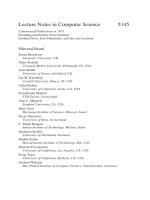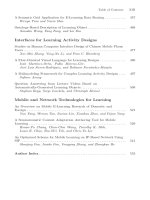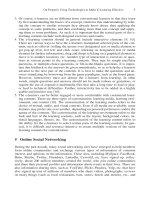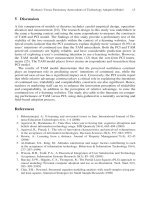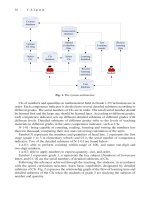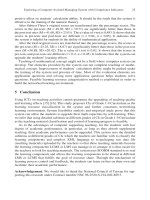Lecture Notes in Computer Science- P23 potx
Bạn đang xem bản rút gọn của tài liệu. Xem và tải ngay bản đầy đủ của tài liệu tại đây (555.56 KB, 5 trang )
100 C. Hornung et al.
2 Background
2.1 State of the Art and Challenges
eLearning systems consist of platforms, pedagogy and scenarios in application do-
mains. Nowadays platforms Moodle [2], Blackboard [3], Ilias [4] are based on cli-
ent/server architecture. eContent is stored on server side management systems and
delivered to learners on the client side. Courses themselves consist of sequences of
pages and atomic assets. To support searching and classification, content can be anno-
tated with standardized meta-data (LOM). Today's eLearning pedagogy principles
follow the traditional model of classroom learning and homework. Application do-
mains are pre-defined by eLearning providers and delivered as pre-fabricated pieces
of learning material.
The state of the art in eLearning environments is defined by computers with Internet-
connection. This technology of web-based trainings (WBTs) is well known and conceptu-
ally mature. However, with the upcoming Web 2.0, the usage of mobiles as devices for
both downloading content as for uploading results or input (see Flickr [5]) becomes more
and more prevalent. With this trend the challenge arises of the development of eLearning
solutions taking the integration of mobile learning into consideration.
Considering the amount of eLearning platforms, the traditional classroom-
metaphor of learning is still prevalent. Contents are delivered to the students, and the
students can download the materials from the platform. Interaction among students
and the teachers is rather rare. Innovative Web 2.0 technologies for cooperative and
collaborative work, such as voice and video over IP, and mLearning play only a mar-
ginal role, although the benefits through the possibilities of collaborative learning
with these tools are promising.
Informal learning today becomes the dominant form of learning [6]. The principles of
the Web 2.0, like the ability to connect people, to distribute information world wide and
discussing ideas with people form all over the world, have similarities to modern educa-
tional theories
[7]. Constructivist Perspectives [8] and Activity Theory [9] emphasise the
importance of learning active, with methods like cooperative learning [10, 11, 12] and
problem-based learning [13] in real-world contexts (situated learning) [14] as well as
learning through games and entertainment [15, 16] becomes more and more popular. On
the contrary, eLearning systems are still frequently used in a teacher centred way (trans-
missive learning) and less for self-regulated [17] learning, reflection, social and commu-
nication skills, problem solving capacities [18]. With these new approaches, the role of
teacher shift to facilitator, while the learners leave their former passive role and start to
embrace an active involvement in the learning process.
Traditional eLearning scenarios focus on enhancing the learning process in the
classroom or support learning at home. Blended learning for example tries to combine
eLearning with the learning of people, who are in one place present. Scenarios in
which the learners are learning outside the school-like environment are not the focus
of these approaches. With mLearning groups of learners can go participate in real life,
while getting guidance through their mobile by solving problem-based scenarios. An-
other problem of the traditional scenarios is the non-standardisation of the scenarios.
Standardisation makes the principles of the scenario explicit and therefore accessible
for evaluation. A comparison of different scenarios is possible and hence best practice
eKnowledge Repositories in eLearning 2.0 101
approaches can be identified. A propos, standardisation is sometimes confounded
with inflexibility. This may result from a narrow understanding of the term standardi-
sation. Standardisation, as we see it, is a way of making teaching process explicit. The
standardisation can be general enough to embrace nearly all teaching processes. For
new teaching approaches new standards will derived using abstract meta-scenarios.
Another advance is the reusability of standardised scenarios for new learning projects.
To sum up, next generation eLearning will extend all the aspects above. Scenarios
will take into account the collaboration of heterogeneous groups. The classical roles
of teacher, tutor and learner will disappear and will be further developed towards situ-
ated skill sharing with dynamic roles of skill providers and skill consumers. This leads
to requirements new eKnowledge repositories have to deal with.
2.2 UNITE - a European-Wide Next Generation Network of Schools
UNITE (Unified eLearning environment for the school) is a thirty-month project par-
tially supported by the European Community under the Information Society Tech-
nologies (IST) priority of the 6
th
Framework Programme for R&D (www.unite-
ist.org). Project is aiming to provide novel services in education for young Europeans
by combining different state-of-the-art technologies in e/mLearning, also taking into
consideration innovation in technology and pedagogy.
The main goal of UNITE is "… to contribute to the improvement of Europe-wide
education in secondary schools based on common, innovative principles in technol-
ogy, pedagogy and in learning scenarios, tested by a well-defined validation frame-
work" [19]. In order to achieve this goal, a number of key objectives were set up: (i)
the pedagogical framework, designed and implemented in the first phase, initiates
daily use of the UNITE platform in classrooms and provide pedagogical concepts for
the e-Learning scenarios; (ii) the technical platform with its communication and co-
operation functionalities supports wide-spread learning along with other learning con-
cepts of the designed pedagogical framework; (iii) the learning scenarios use full
potential of the platform and developed pedagogical concepts so as to motivate learn-
ers and deliver innovation in the classroom.
It is important to note that other objectives concern the establishment of a Network
of Schools, the development of a Europe-wide repository of re-usable m/eLearning
content, the development of an adequate validation framework, detailed socio-
economic evaluation of UNITE as well as a carefully designed exploitation plan.
Teaching and learning process implies the usage of fundamental material delivered
not only in English, but also on partners’ mother tongue: (i) eLearning scenario tem-
plate along with more than 20 different scenario examples [20], (ii) Content develop-
ment handbook [21] and (iii) Teachers' handbook conveying the pedagogical princi-
ples of UNITE [22].
3 eLearning 2.0 Technical Platforms
3.1 Functional Design
A Web 2.0 eLearning platform seamlessly integrates three distinct technologies in-
cluding their diverse functionalities into usable and effective e/mLearning environ-
ment [23]: (i) an eLearning portal, supporting the learning process and specifically,
102 C. Hornung et al.
group-oriented learning in classes of pupils, (ii) an eKnowledge repository, containing
traditional eLearning material (like assets, pages and courses), but also images shot
during "learning at excursions", knowledge sharing sessions and best practices, and
(iii), a mobile learning component, that allows to contact both other learners as well
as the school-server and to communicate taking in mobile learning scenarios.
3.2 System Architecture
From a system design point of view, modularity and re-usability are key point. Mod-
ern Web-based systems are therefore based on a so-called Webservice-oriented archi-
tecture (SOA). This supports the configuration and integration of systems based on
the functionality of services avoiding any implementation detail.
Fig. 1. eLearning 2.0 platform: System archi-
tectture
Fig. 2. eLearning 2.0 platform: Functional
design
3.3 The UNITE Platform
The UNITE platform implements the concepts explained above. The provided func-
tionality covers an eLearning portal, an eKnowledge repository, and a mobile learning
component. The system architecture integrates three already existing components.
The portal is based on Microcosmos [24], the enhanced eKnowledge repository comes
from eLearning repository Infopool [25] and mobile learning is implemented using
the mediaBoard built by [26]. The communication between these components is real-
ized using web services (see Fig. 1). This technology supports both the integration of
already existing modules (as in UNITE) as well as the later integration/extension of
new modules.
The UNITE platform has two access points: (i) the learning portal and the learning
management system are directly accessed via a web server (),
while (ii) the mobile devices are connected to the platform via a dial-in server. The
knowledge repository is a background service behind the web server (see Fig. 2).
3.4 The Platform Validation
In order to verify the validity of technological and pedagogical developments, the
validation of the UNITE platform and its e/mLearning scenarios was performed. The
validation results show the appropriateness, meaningfulness and usefulness of both
eKnowledge Repositories in eLearning 2.0 103
the system and the scenarios [27]. In the following we refer to the procedure and end-
results of the platform evaluation. Iterative user-centred design of the UNITE system
comprised an evaluation methodology [28], by means of which the relevant platform
characteristics were quantified, validated and weaknesses identified. Both low-fidelity
(paper-based) and high fidelity (computer-based or interactive) prototypes were tested
by UNITE users. A total of 62 teachers and 131 pupils (ranging between 11 and 18
years of age) involved in the project along with 28 partner members and observers
participated in two iterations of the evaluation. In addition, 5 double experts from the
usability and e-learning field were employed also.
The evaluation procedure of the UNITE system comprised (i) heuristic evaluation
and (ii) scenario-based usability testing, including pre-experiment multi-choice ques-
tionnaire, task-based user testing, memory test, usability satisfaction questionnaire
and semi-structured interview. In order to make a decision regarding whether or not
there is sufficient evidence that the platform has met its objectives, several goals were
set up. For example, accuracy of task completion, as objective performance measure-
ment of effectiveness, for students was 78,3% and for teachers 70,59%, while task
completion time, as objective performance measurement of efficiency, for students
was 14,75 minutes and for teachers 24 minutes (our goal was to make it under 20 and
30 min respectively). The overall conclusion is that UNITE is a good system but
would benefit from some alterations (ibid.).
4 Enhanced eKnowledge Repositories
As already mentioned above, there is a fundamental further development from tradi-
tional eLearning content towards Web 2.0 material. Web 2.0 is much more focused on
the knowledge sharing between heterogeneous communities. Because Internet tech-
nologies are used, the term "eKnowledge" (similar to eLearning) will be used in the
following.
4.1 eKnowledge Domains
In eLearning 2.0, content includes not only traditional SCORM-compliant eLearning
content (assets, pages and complete courses), but, in addition, mLearning content (im-
ages shot using mobiles or handhelds), information about groups and results of col-
laborative learning. All information can be tagged with meta-data and, herewith, can
be searched using terms like keywords, authors and the like. Keywords can be as-
signed either individually, or based on commonly agreed glossary. This allows the
uniform categorization of data and, herewith, the re-use on a European-wide scale.
On top of the meta-data, eKnowledge domains or eLearning contexts are defined.
An eKnowledge domain is, using semantic web terminology, defined as a ontology,
consisting of topics and associations between them. The topics consist of categories of
meta-data, while the associations describe the relations between them. An eKnowl-
edge domain forms a semantic space, in which the meta-data as well as the data have
a context-specific meaning. Correspondingly, the same data and meta-data may have
different meaning in different knowledge domains. In UNITE, eLearning contexts are
defined as reference scenarios. Consequently, topics, associations and meta-data have
a context-specific meaning.
104 C. Hornung et al.
To manage eKnowledge content, an eKnowledge repository must handle all the
content types above as first class entities. In UNITE, the eKnowledge repository is
based on a traditional eLearning repository, extended by the features to deal with con-
tent produced by mobile devices, the management of uniform meta-data spaces across
different items and of complex ontologies for both users as well as content.
4.2 Content Patterns
Re-usability and uniform layout are key requirements in eLearning. Because content
production is very expensive the re-use of whole courses or at least parts is essential.
eLearning content has often to follow a certain CI, what makes adaptability necessary.
In eLearning 2.0, re-usability and uniform layout become even more crucial, because
of the large and heterogeneous groups of content producers and consumers. A solu-
tion for these requirements is the usage of patterns, as well known from software de-
sign. While there may be numerous kinds and types of patterns, UNITE has concen-
trated on two of them: page-patterns and course-patterns. Page patterns define the
types of pages (like introduction, presentation, quiz, test) as well as their layout (text
page, page with graphics/animation, single choice / multiple choice tests and the like).
These page patterns are described in UNITE's teachers' handbook and form a general
guideline for the production of content.
Course-patterns are a new concept, first introduced in UNITE. A course is a learn-
ing unit that can be executed and navigated. Currently, simple sequencing, the stan-
dardized way of navigation, is implemented. A course consists of different types of
course elements (such as modules, questions), which reference locations and meta-
data in the repository. Because there are just references, content can easily be shared
among different courses. Courses themselves are treated as first class elements of the
eKnowledge repository. They have specific meta-data that can serve as search criteria.
Courses can be re-used "as-is" or can be modified with "copy & paste". Moreover,
abstract course templates can be modelled and stored as course patterns. These pat-
terns define only a navigation structure through different course elements, but have no
content yet. They can be instantiated with specific content in the same or in different
contexts.
The combination of both, page patterns and course patterns, allows the creation of
courses with the same look and feel for different pedagogic situations, a prerequisite
for a wide network of schools with different knowledge domains.
4.3 eKnowledge Management Tools
UNITE provides tools for the management of the eKnowledge repository: a meta-data
editor and a course editor. The web-based meta-data editor is based on the interna-
tional standard LOM (learning objects meta-data), and can be configured to cover just
the necessary data for a specific knowledge domain, and, herewith, allows annotation
with minimal efforts and maximal confidence, because only the formally correct key
word dictionary is provided. Key words are stored in a dictionary and a search engine
is integrated in the editor.
The platform also provides an interactive course editor, a web-based application
managing courses as XML files. Courses can be created by drag&drop of course
